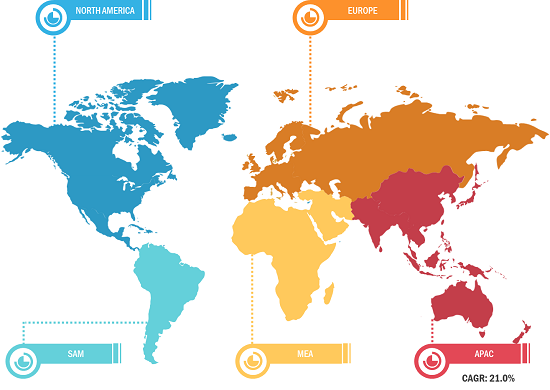The Self-Tanning Products Market size is expected to reach USD 1519.59 Million; registering at a CAGR of 5.9% from 2022 to 2028, according to a new research study conducted by The Insight Partners
Strategic Development Initiatives by Key Market Players
The report highlights key factors driving the self-tanning products market growth and prominent players along with their developments in the market.
Self-tanning products consist of a wide category of products, including creams and lotions, mousses, mist, sprays, sticks, serums, drops, waters, and others. These products are available in various skin tones and formulations. The demand for self-tanning products is increasing significantly as consumers prefer tanned or bronzed skin tones. Moreover, the awareness of the side effects of direct exposure to the sun to achieve tanned skin is increasing among people, which is boosting the demand for self-tanning products globally.
Global Self-Tanning Products Market Breakdown – By Region
Self-Tanning Products Market Forecast to 2028 - COVID-19 Impact and Global Analysis by Product Type (Cream & Lotion, Serum, Mist, and Others), Category (Natural & Organic and Conventional), and Distribution Channel (Supermarkets & Hypermarkets, Convenience Stores, Online Retail, and Others)
Self-Tanning Products Market Dynamics and Analysis by 2028
Download Free Sample
The self-tanning market is growing with an upward trend. Manufacturers are making significant investments in research & development, partnerships, and collaborations to launch innovative products to attract a large consumer base. For instance, in August 2021, Cosmopolitan launched a self-tanning line. The collection is cruelty-free, vegan, and nut-free. Cosmopolitan teamed up with Devoted Creations, a tanning company, to launch CosmoSun, a line of tanning products and other sun-care items. The five-item line includes Sunless Mousse, Instant Body Bronzer, Sun Lotion with Shimmer, Overnight Sunless Lotion, and Liquid Sunshine tanning water. Such product launch and development initiatives are expected to drive the demand for self-tanning products and propel the market growth over the forecast period
A few players operating in the global self-tanning products market include Bondi Sands Pty Ltd, KAO Corp, PZ Cussons Plc, Supernova UK Pty Ltd, Epic Etailers LLC, Loreal SA, HotHouse Beauty Ltd, Johnson & Johnson, Coty Inc, and Edgewell Personal Care Co. Players operating in the self-tanning products market are focusing on providing high-quality products to fulfill customer demand. They are also focusing on strategies such as investments in research and development activities and mergers & acquisitions.
Impact of COVID-19 Pandemic on Self-Tanning Products Market
The COVID-19 pandemic adversely affected economies and industries due to lockdowns, travel restrictions, and business shutdowns. A few production plants in the consumer goods industry were closed in the initial phases of the pandemic. The shutdown of the plants disturbed the supply chains, manufacturing, delivery schedules, and sales of goods. As a result, in 2020, various companies announced possible delays in product deliveries and a slump in future sales of their products. Due to the pandemic, cosmetic product manufacturers had to shut down a few of their operations and manufacturing facilities as a result of the labor shortage. In addition, numerous beauty specialty stores were shut down to prevent the spread of SARS-CoV-2, which hampered the market growth. According to the 2020 annual report of L'Oréal Paris, sales of makeup & sun protection products were severely affected during the COVID-19 outbreak, and the market witnessed a decline of 15% in revenue in 2020. Moreover, governments of various countries across the globe announced lockdowns that reduced the use of different cosmetic products, such as self-tanning products, which were not included in the necessary products during the crisis. Also, significant disruptions in manufacturing facilities and raw material sourcing hampered the growth of the self-tanning products market. However, in 2021, the economies started reviving their operations, and various industries resumed their business activities. Moreover, manufacturers were permitted to operate at full capacity, which helped them overcome the demand and supply gap challenge. All these factors have positively influenced the growth of the self-tanning products market.
The report includes the segmentation of the global self-tanning products market as follows:
The global self-tanning products market is segmented on the basis of product type, category, distribution channel, and geography. Based on product type, the market is segmented into cream & lotion, serum, mist, and others. Based on category, the self-tanning products market is bifurcated into natural & organic and conventional. Based on distribution channel, the market is segmented into supermarkets & hypermarkets, convenience stores, online retail, and others. By geography, the global self-tanning products market is broadly segmented into North America, Europe, Asia Pacific, the Middle East & Africa, and South & Central America.
Contact Us
Phone: +1-646-491-9876
Email Id: sales@theinsightpartners.com